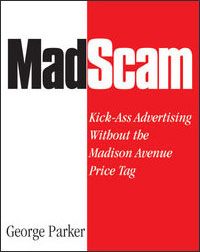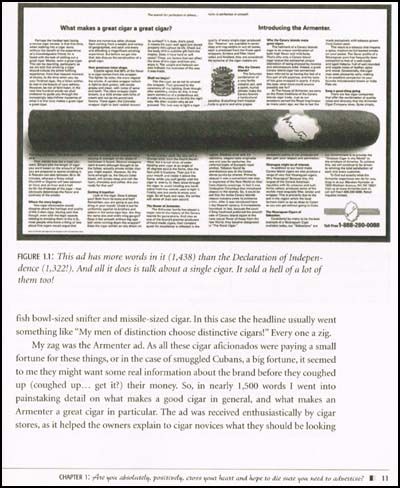Information-First Advertising and Marketing
In today’s advertising and marketing world, it seems most advertisers and marketers have fallen under the spell that nobody reads copy and anything longer than a Tweet.
If you study advertising from the mid-20th century you would immediately see that copywriters back then relied heavily on what I call the power of information-first advertising and marketing.
If you compare that old-school approach to advertising today, it would seem the “less is more” philosophy is the new normal, but I would like to use this article as a reminder that this should never be the law that rules all your advertising and marketing.
Yes, there are times when a short, pithy message can pack more punch than a longer one, but like just about everything in life, one needs to understand the context of the situation to determine the best path forward.
One of the most profound “laws” I ever heard from Dan Kennedy was, “Time commitment precedes financial commitment”, and if you think about this he is exactly right.
If you are selling a high-ticket or unique item, the more you get can a prospect to invest in time with you before the sale (through information-first advertising and marketing), the higher your chance for closing the sale.
In my last article, I showed you a two-page, copy-heavy print ad to sell organic mattresses that is like a money-machine every time the business owner runs it.
If you are selling a normal generic department store-style mattress, you probably don’t need a lot of information, since the target market for that type of mattress doesn’t require it. In this case, the lowest price usually dictates what is bought.
However, if you are selling a $15,000 hand-made, organic mattress, this is a completely different type of sales process and proceeding with an information-first approach is required.
And speaking of mattress sales, check out this example of information-first advertising and marketing from 1903 which features a 144-page book as the call-to-action.
Last year, I showed you a few other examples of information-first advertising and marketing, including a famous one from David Ogilvy for Rolls Royce, and today I want to share another ad example worthy for your swipe file.
This one is selling something that costs a lot less than a $15,000 mattress or a Rolls Royce, but given the context of the time the ad was run and how the copywriter knew his target market – his information-first approach results in a classic ad in my opinion.

The ad comes from George Parker and I first saw it in his book, MadScam. While this book is out-of-print, you can find used copies on Amazon and ebay, and I suggest you grab a copy for your library. I contacted George and purchased a box of them to give out as gifts and I am sure I will be giving away a copy soon here on my blog.
On page 11 of MadScam, George showed this copy-heavy ad, which immediately caught my eye. You can click on it to bring up a larger, more readable version.
According to George and I quote, “This ad has more words in it (1,438) than the Declaration of Independence (1,322!). And all it does it talk about a single cigar. It sold a hell of a lot of them too!”
This ad, which ran back in the 1990’s during the cigar boom, does a tremendous job of engaging the reader and taking him on a journey to ultimately purchase an Armenter cigar. The copy and style is worthy of your study, and while it appears Armenter cigars are no longer around (like a lot of cigars produced during the craze), it doesn’t diminish the success and style of this ad.
I thought you would find George’s description of this ad and the context in which he created it interesting. What follows is an excerpt from his book, MadScam.
When it comes to producing great advertising, the single most important resource you can work with is information. In fact, you can never have too much of it. All the truly great campaigns of the last 50 years have been based on solid information, rather than bullshit. One example of this prerequisite virtue is the classic David Ogilvy ad for Rolls Royce with the headline, “At 50 miles an hour, the loudest noise you can hear is the ticking of the dashboard clock.” Ogilvy didn’t spout pseudo engineering, “Power Glide Auto Gismo smoothes the ride and puts you in charge.” Or snob appeal, “When you arrive in your pink Chateau La Grande, the girls at the country club will die with envy.” Instead he featured the unmatched craftsmanship, quality, and design of the car via the least talked about piece of equipment in it-the clock!
This is using information as a solid selling tool in a way that allows you to zig when everyone else is zagging! Figure 1.1, an ad I did for Armenter cigars a few years ago, is a perfect example of what I mean.
When the cigar craze hit America in the late ’90s and humidors and smoking rooms were sprouting up all over the place, fortunes were being spent on ad campaigns for both established and new brands. All the ads fell into two general categories. Sleek looking guys wearing $5,000 suits while sitting in opulent surroundings, such as board rooms and country clubs with lots of mahogany and sporting prints on the walls. In one hand was a sparkling Waterford crystal brandy snifter the size of a goldfish bowl, in the other was a King Carlos Fantasia stogie the size of a nuclear missile. The single line of copy was usually something like “Men of distinction choose a distinctive cigar!” The second category visualized a hot chick falling out of a very low cut dress, sitting in a lush interior clutching the same gold fish bowl-sized snifter and missile-sized cigar. In this case the headline usually went something like “My men of distinction choose distinctive cigars!” Every one a zig.
My zag was the Armenter ad. As all these cigar aficionados were paying a small fortune for these things, or in the case of smuggled Cubans, a big fortune, it seemed to me they might want some real information about the brand before they coughed up (coughed up … get it?) their money. So, in nearly 1,500 words I went into painstaking detail on what makes a good cigar in general, and what makes an Armenter a great cigar in particular. The ad was received enthusiastically by cigar stores, as it helped the owners explain to cigar novices what they should be looking for in a good cigar. It was reprinted as an instore display piece, and was even included in every box of Armenters.
It sold a heck of a lot of cigars. Particularly to people who wanted to jump in on the craze, yet had no prior experience with cigars and needed the reassurance that they were paying out money for a reputable product. Which reinforces my point that you cannot create good advertising in a vacuum. If you lry, you end up with the zig stuff I described above, which gives no one a solid reason why they should contemplate doing business with you. Start off with as much information as you can. It doesn’t matter if you discard or fail to use 90 percent of it, the remaining 10 percent will contain that one nugget that will separate you from everyone else in the market. I’ll also be talking about how you go about doing this in later chapters.



